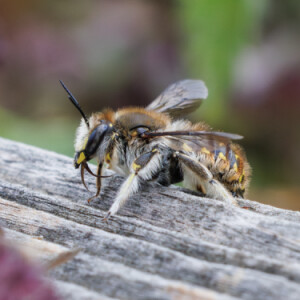Long-tongued
One way in which entomologists categorise bees is by the length of their tongues. In terms of the number of bee species there are worldwide, not many are truly long-tongued, but the mason, leafcutter, carpenter and carder bees are among them, together with some bumblebees (in the UK, Bombus hortorum has a tongue that's almost twice as long as that of its nearest "rival"), and the Anthophora flower bees.
Long-tongued bees are adapted for feeding from deeper flowers such as foxgloves, honeysuckle and comfrey, and the various members of the Lamiaceae, such as mints, dead nettles and sages. However, a study in the USA a few years ago suggested that longer-tubed flowers are becoming scarcer as the climate changes, and that long-tongued bees are now undergoing rapid evolution, shortening their tongues so that they can more easily feed from a wider range of plants.
My second photo tonight shows the same male Wool Carder as my main image, but this time taking a few minutes from his busy feeding and mating schedule to sort out his tongue. Though when I say "sort out", I mean... that I haven't the least idea what he was doing, except that he was waving these two elements back and forth quite energetically. Bee tongues are such complicated structures that I'd advise you to tread carefully towards the many on line descriptions of how they work, lest you too suddenly find that you've spent an entire morning you'll never see again, surfing the entomological web. And the tongues of long-tongued bees are even more complex than those of short-tongued species. But.
Essentially the actual tongue, or glossa, is a flexible tube, hairy and with a tiny inverted cup at the end, with which the bee laps nectar. The glossa is supported by a four-part sheath, formed by two labial palps and two galeae, which lock together to form a suction tube around the glossa. This five-part structure, known as the proboscis, is supported by the mandibles while the bee is feeding, and protected by the mandibles and the upper "lip" or labrum when it's retracted. Nectar is drawn up into the bee's pharynx by the action of muscles (very strong, in the case of long-tongued bees) that attach to the mandibles.
None of this, sadly, makes my second photo clearly explicable. My best guess is that the closer, longer structure is the labium - that is, the glossa plus its palps, and the further, slightly shorter structure, which in some of my photos was obviously hinged, is the right maxilla. But if anyone knows better, I'd be delighted to be put straight!
Should you have an inexhaustible curiosity about this topic, and a morning to spare, you could do worse than start with the three clearest explanations I managed to find, which are here, here, and here.
R: C3, D7.


Comments
Sign in or get an account to comment.


